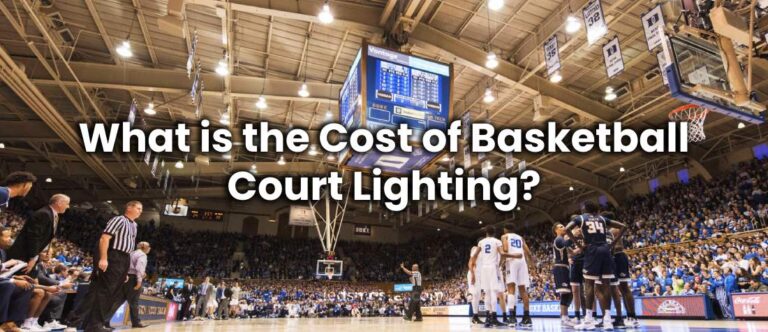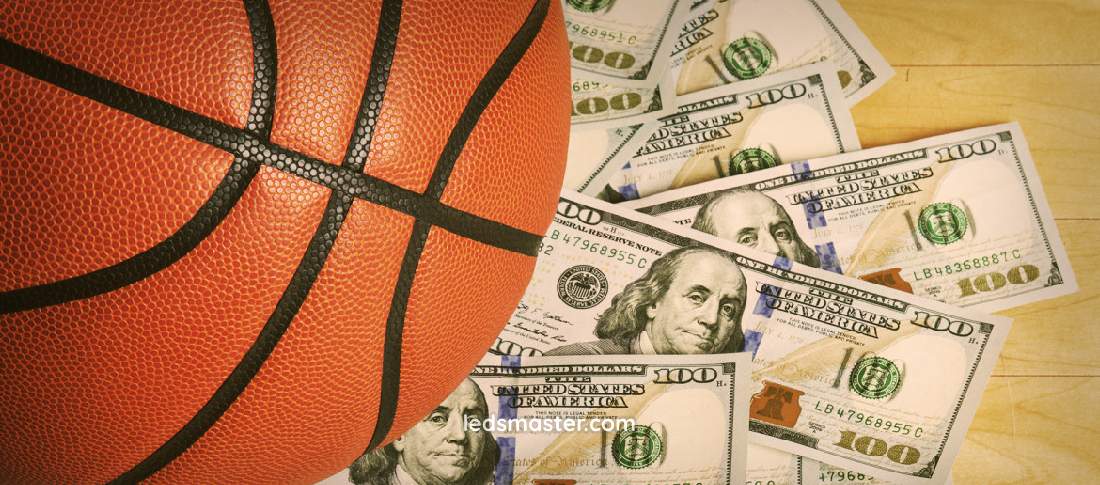
Understanding basketball court lighting costs is essential for optimal performance and safety. Explore the expenses for indoor and outdoor courts, including installation and maintenance, and discover how LED lighting offers long-term savings and enhanced play.
Get your complimentary lighting design today
The right lighting ensures that players can perform at their best while also enhancing the spectator experience. Among the various lighting options available, LED lighting has emerged as the preferred choice due to its efficiency, durability, and long-term cost-effectiveness. In this article, we will delve into the cost structure of basketball court lighting, covering both indoor and outdoor courts, and examine operational and maintenance costs. We will also explore the benefits of choosing LED lighting and provide other relevant lighting information for basketball courts.
Table of Contents
ToggleThe initial cost of lighting an indoor basketball court includes the price of the lighting fixtures, installation labor, and any necessary electrical work. For indoor courts, the cost can vary significantly based on the size of the court and the type of lighting fixtures used. Traditional lighting systems, such as metal halide or fluorescent lights, may have a lower upfront cost compared to LEDs. However, LEDs have become more affordable over the years, narrowing the cost gap.
LED fixtures are more expensive initially, but they offer several advantages that justify the higher price. High-quality LED fixtures suitable for indoor basketball courts can range from $200 to $500 per unit. The number of fixtures needed will depend on the court’s dimensions and the desired illumination levels, typically measured in lux. An indoor basketball court generally requires around 200 to 300 lux for recreational use and 500 to 750 lux for professional or televised games.

Installation costs for LED systems can vary based on the complexity of the project. This includes the cost of mounting fixtures, running electrical wiring, and integrating any control systems. On average, installation costs can range from $3,000 to $8,000 for a standard indoor court. It is essential to work with professional installers to ensure the lighting is evenly distributed and meets the necessary safety standards.
Lighting an outdoor basketball court involves additional considerations such as weatherproofing and higher illumination levels due to ambient light conditions. The initial cost includes purchasing weather-resistant fixtures, poles, and electrical work. LED fixtures designed for outdoor use are typically more robust and slightly more expensive than indoor fixtures.
Outdoor LED fixtures can range from $300 to $800 per unit, depending on their specifications and durability features. Outdoor courts generally require higher illumination levels, typically around 200 to 400 lux for recreational play and up to 500 lux for competitive games. The total number of fixtures will again depend on the court’s size and desired lighting levels.
Installing lighting for outdoor courts involves additional costs for poles and weatherproof electrical components. These costs can range from $5,000 to $15,000 depending on the court’s location and specific requirements. Poles must be tall enough to provide adequate light coverage without causing glare, and the electrical system must be protected against the elements.
| Item | Indoor Price Range (USD) | Outdoor Price Range (USD) |
|---|---|---|
| LED Fixtures (per unit) | $200 – $500 | $300 – $800 |
| Number of Fixtures Required | 20 – 40 | 20 – 40 |
| Total Cost for Fixtures | $4,000 – $20,000 | $6,000 – $32,000 |
| Electrical Work and Installation | $3,000 – $8,000 | $5,000 – $15,000 |
| Poles (Outdoor Only) | N/A | $2,000 – $5,000 |
| Total Initial Installation Cost | $7,000 – $28,000 | $13,000 – $52,000 |
One of the most significant advantages of LED lighting is its energy efficiency. LEDs consume significantly less power compared to traditional lighting systems, resulting in substantial savings on energy bills. For instance, a typical metal halide fixture might consume around 400 to 1,000 watts, while an equivalent LED fixture consumes only 100 to 300 watts. Over time, the reduced energy consumption leads to lower operational costs.
LED lights have a much longer lifespan compared to traditional lighting options. While metal halide lamps may need replacement every 10,000 to 20,000 hours, LEDs can last up to 50,000 to 100,000 hours. This extended lifespan means fewer replacements and lower maintenance costs over time. Additionally, the consistent performance of LEDs ensures that the lighting quality remains high throughout its lifespan.
LED lighting systems require less frequent maintenance compared to traditional lighting. Routine maintenance tasks for LEDs include periodic cleaning of the fixtures and checking for any electrical issues. The reduced need for frequent bulb replacements and lower risk of fixture failure contribute to the overall cost-effectiveness of LED lighting.
LED fixtures are known for their durability and reliability. They are resistant to shock, vibration, and extreme temperatures, making them ideal for both indoor and outdoor basketball courts. This durability translates to lower long-term maintenance costs and fewer disruptions to games due to lighting failures.
One of the primary reasons for choosing LED lighting is its superior energy efficiency. LEDs convert a higher percentage of electricity into visible light, reducing wasted energy in the form of heat. This efficiency not only lowers energy costs but also contributes to environmental sustainability by reducing the carbon footprint.
LED lights offer excellent lighting quality with high color rendering index (CRI) values, ensuring that colors appear natural and vibrant. This is particularly important for basketball courts, where clear visibility of the ball, court lines, and players is essential. LEDs also provide uniform light distribution, reducing shadows and glare, which can improve player performance and safety.
LED lighting systems are highly customizable, allowing for various control options such as dimming, motion sensors, and programmable lighting schedules. These features enable facility managers to optimize lighting based on usage patterns, further enhancing energy efficiency and extending the lifespan of the fixtures.
For outdoor basketball courts, it is crucial to address light pollution concerns. LED fixtures with proper shielding and directional lighting can minimize light spill and glare, ensuring that the light is focused on the court and not on surrounding areas. This not only improves the playing experience but also reduces the impact on nearby residents and wildlife.
Basketball court lighting must comply with specific standards and guidelines to ensure safety and performance. For instance, the Illuminating Engineering Society (IES) provides recommendations for sports lighting, including minimum illumination levels, uniformity ratios, and glare control. Adhering to these standards helps create a safe and enjoyable environment for players and spectators.
LED lighting is environmentally friendly, as it contains no hazardous materials like mercury, commonly found in traditional lighting systems. Additionally, the longer lifespan of LEDs means fewer fixtures end up in landfills, reducing waste. Choosing LED lighting for basketball courts aligns with sustainable practices and promotes environmental responsibility.
Investing in LED lighting for basketball courts, whether indoor or outdoor, offers numerous benefits that justify the initial costs. The energy efficiency, long lifespan, and reduced maintenance requirements of LED fixtures lead to significant long-term savings. Moreover, the superior lighting quality and customizable options enhance the playing experience and ensure safety for players and spectators alike. As LED technology continues to advance, it remains the best choice for modern basketball court lighting, providing a cost-effective and sustainable solution for sports facilities.